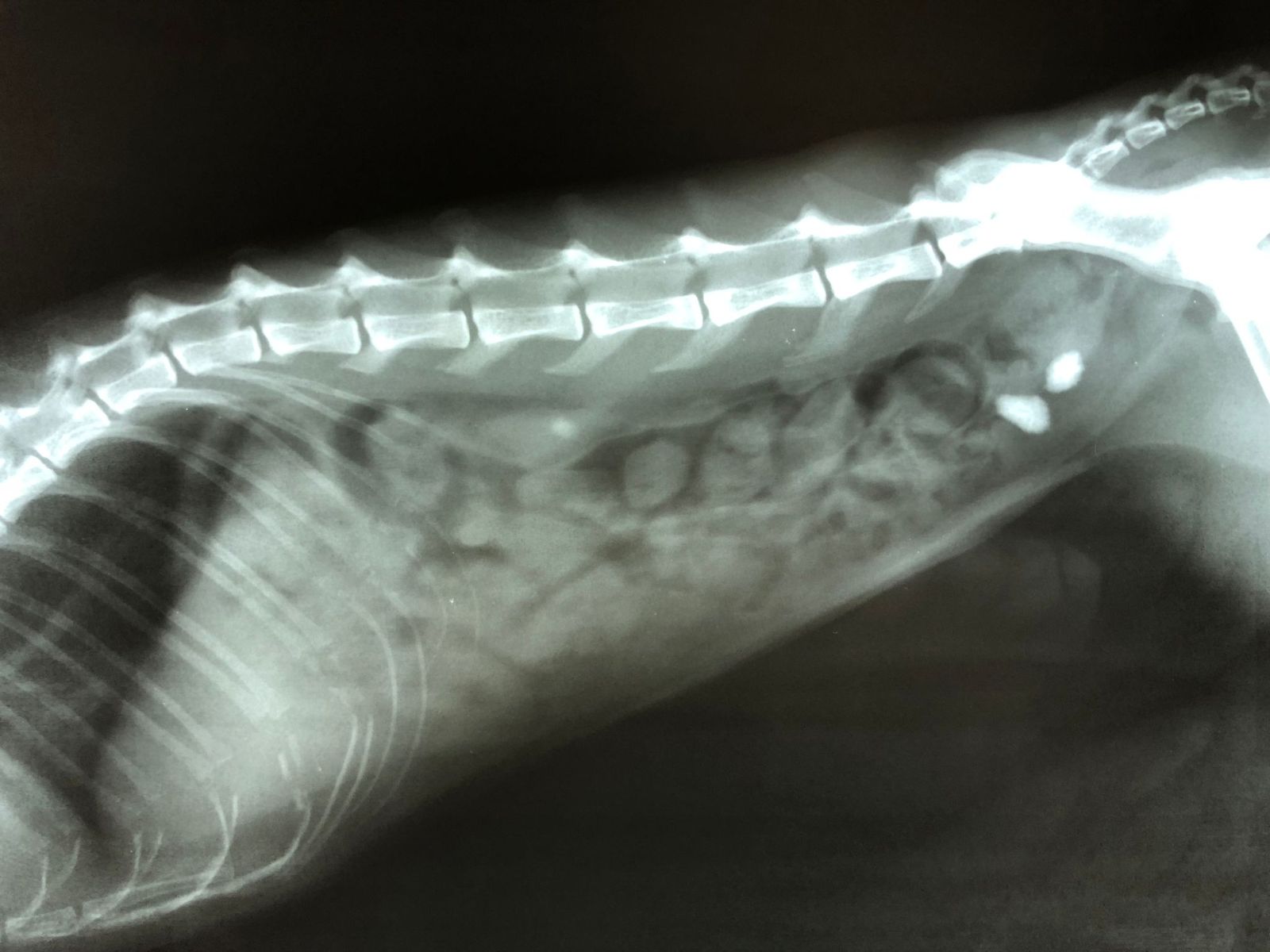A cat with bladder stones tend to have the classical symptoms of feline idiopathic cystitis: straining to urinate, bloody urine, urinating in unusual places, genital licking.
Diagnosis
In the course of testing to pursue these symptoms, a radiograph is taken and a stone or group of stones is seen in the urinary bladder. Urinalysis can be done in order to further predict the nature of the stones; such as ph and bacterial activity. Culture and sensitivity of the urine sample is also beneficial for some cases.

Treatment
CYSTOTOMY (SURGICAL REMOVAL) is the fastest way to resolve a bladder stone issue. To accomplish this, the cat is anesthetized and an incision made through the belly. The bladder is lifted into view, opened, and stones are removed. Cultures to rule out infection are obtained if not done previously. The bladder is carefully stitched in several layers. The belly is closed and the patient is awakened. Pain medications and antibiotics are routinely administered after surgery. The patient usually remains hospitalized for a day or two, under close observation for urine. The stones themselves will be sent to a lab for analysis. It is normal for some blood to be evident in the urine for several days after the surgery.
Prevention
Retrieving the stones is generally the easier part of calcium oxalate stone management. Prevention of future stones is more challenging. If the patient is one of the 35% with an elevated blood calcium then steps to control the calcium level and determine why it is high should be taken. If blood calcium levels are normal, the following step by step regimen is recommended:
- STEP ONE: FEED A NON-ACIDIFYING DIET THAT MINIMIZES CALCIUM OXALATES IN URINE.
Such diets use a normal calcium content, a moderate magnesium content, and citrate to bind urinary calcium. E.g. Hills c/d multi-care diet. Canned diet is preferred over dry food due to the high water content of canned foods. Part of the goal is to create a dilute urine and the extra water consumption is helpful. Meal feeding rather than free feeding also may be helpful in maintaining the desired urinary pH.
Avoid supplementation with vitamin C. Vitamin C is converted to Oxalic acid which modifies into oxalate. Be careful of pet vitamin supplements. In 2-4 weeks, a urinalysis is performed to see if there are calcium oxalate crystals present (there should not be), if the urine is dilute (the specific gravity of the urine should be less than 1.020), and if the urine pH is alkaline (it should be 6.8-7.5).
- STEP TWO: CORRECTING PROBLEMS IN THE FIRST URINALYSIS
If the urine specific gravity is > 1.020, this means that the urine is not adequately diluted. The cat will need to drink more water. This is best accomplished by increasing the percentage of canned food in the diet. If the urinary pH is <6.5, the urine is too acidic and potassium citrate must be given as a supplement, either as a chewable tablet, capsule or oral liquid. Another urinalysis is performed in 2-4 weeks.
- STEP THREE: IF OXALATE CRYSTALS ARE PRESENT, THE URINE IS NOT DILUTE, OR IF THE PH OF THE URINE IS ACID (pH < 7.5)
THE FOLLOWING STEPS ARE TAKEN: A thiazide diuretic is added to dilute the urine and correct the necessary electrolyte balance in the urine. Vitamin B6 is supplemented. A population of cats has been identified for which a B-6 deficiency leads to oxalate stone development. This may or may not be helpful but is worth trying. The vitamin B-6 deficiency leads to an increase in blood oxalic acid which in turn leads to an increase in urine oxalates.
A different food may need to be selected once a urinalysis with the appropriate values is obtained, the patient is rechecked every 3-6 months with both a urinalysis and radiograph. If the patient is female, stones may be identified when they are still small enough to be induced to pass naturally.
A male cat will require surgery to remove stones as the male tract is invariably too small for the passage of stones.
